Mid-Term Self-Assessment Report of the United States' 5th Open Government National Action Plan
⚠ Important Notice: This website is moving!
Starting August 29, 2024, this website will be relocated to https://www.gsa.gov/usopengov. Please update your bookmarks, as the current site will be decommissioned shortly after the launch. Legacy URLs may take up to a week to redirect. We appreciate your continued support!
Posted August 5, 2024
Please find below the 5th Open Government National Action Plan of the United States’ Mid-Term Self-Assessment Report 2022-2024 that the U.S. Open Government Secretariat submited to the Open Government Partnership on August 5, 2024.
5th Open Government National Action Plan of the United States’ Mid-Term Self-Assessment Report 2022-2024
Download PDF Version of Mid-Term Self-Assessment
Table of Contents
- A Letter from GSA Administrator Robin Carnahan
- Action Plan Process
- Use of IRM Recommendations
- Analysis of the Commitment
- Lessons and Insights
- Recommendations
A Letter from GSA Administrator Robin Carnahan
President Biden has referred to the effort to sustain and maintain democracy at home and abroad as “the defining challenge of our time.” We want to realize lasting peace and prosperity worldwide; we know that U.S. foreign and domestic policies play an important role in achieving those goals.
Thirteen years after the United States co-founded the Open Government Partnership (OGP), our involvement remains an important vehicle for promoting democratic resilience globally. The foundational open government principles – to promote participatory, inclusive, accountable, and transparent democracy – resonate not just across America, but across democracies worldwide.
I saw that firsthand last summer when I represented the U.S. government at the OGP Summit in Tallinn, Estonia. I met with leaders from across governments and civil society, all of whom were passionately committed to those principles – and all of whom were eager to connect, collaborate, and continue to strengthen the partnerships that drive open government forward.
Protecting and strengthening public participation in governance is fundamental to the United States’ leadership role on the international stage and the U.S. Fifth Open Government National Action Plan (NAP 5), released in December 2022, addresses these needs. The NAP 5 and the initiatives detailed in the 36 commitments focus on initiatives across the whole of the U.S. government, such as broadening public access to government data, increasing civic engagement, innovating in public service delivery, tackling corruption, and upholding fairness in the judicial system. Furthermore, we’ve woven in a cross-cutting theme of advancing equity and inclusion for underserved communities in support of the U.S.’s equity initiatives.
In this mid-term self-assessment report, the U.S. General Services Administration (GSA) Open Government Secretariat reviews progress made to date and shares lessons learned and resulting recommendations that have emerged. We should take pride in the accomplishments these commitments represent, as well as use them as inspiration for expanding government efforts further. For example, the launch of the National Law Enforcement Accountability Database, the White House’s new Environmental Justice Scorecard, and the findings of the Subcommittee on Equitable Data’s progress report have each enhanced transparency and accountability.
As we look to the future, we know that it takes everyone working together to prioritize and uphold these principles – and we feel confident that we are continuing on the path toward enhancing public trust, being responsive to the public’s needs and priorities, and empowering citizens with the tools they need to hold the government accountable for delivering outcomes in the public interest. That is what democracy is all about.
- Robin Carnahan - Adminstrator, U.S. General Services Administration
Action Plan Process
The Biden-Harris Administration developed the U.S. NAP 5 in 2021 and 2022, utilizing a number of public feedback mechanisms to collect input. The government reviewed, analyzed, and incorporated the public feedback to create NAP 5, which was published in December 2022. While the participation and co-creation process for the development of the U.S. Fifth Open Government National Action Plan met the letter of the Open Government Partnership’s relevant OGP Participation & Co-Creation Standards, we recognize that due to resource and time constraints, it fell short in fully meeting the spirit of co-creation with civil society (see Lessons and Insights section at the end of this document). Per the OGP Independent Reporting Mechanism (IRM) report, the U.S. NAP 5 development process reflected an adherence to relevant OGP Participation & Co-Creation Standards, and in particular Standards 3 and 4:
- In alignment with Standard 3, the U.S. Government provided inclusive participation opportunities during the action plan’s co-creation in the form of “engagements, listening sessions, and town halls with members of the public, equity-oriented civil rights and advocacy organizations, and outside experts on equitable delivery of public services.” [1]
- The co-creation plan for NAP 5 established a timeline for the various phases of the co-creation process. This timeline involved hosting a series of engagement sessions in 2021 and 2022 which served to provide updates to civil society on the status of the National Action Plan, to gather feedback on draft themes and commitment areas, and to discuss new ideas for themes and commitments. [2] Recordings of these sessions—hosted in November of 2021 and April and May of 2022—are available on the Open Government Secretariat’s YouTube playlist as well as through directly embedded videos on their respective web pages (see footnote 2).
- Beyond the engagement sessions, public and civil society stakeholders had the opportunity to provide ideas and problem statements that helped form the basis of commitments in the new plan through online forms for community outreach, research, and problem statements. The White House Office of Science and Technology Policy released the Request for Information on Equitable Data Engagement and Accountability on September 2, 2022, which also provided stakeholders an opportunity to submit responses that would “inform development of the United States’ Open Government Partnership National Action Plan that furthers the principles of open government.” All of the contributions provided by the public to this FRN were compiled and are publicly available online.
- The co-creation plan for NAP 5 established a timeline for the various phases of the co-creation process. This timeline involved hosting a series of engagement sessions in 2021 and 2022 which served to provide updates to civil society on the status of the National Action Plan, to gather feedback on draft themes and commitment areas, and to discuss new ideas for themes and commitments. [2] Recordings of these sessions—hosted in November of 2021 and April and May of 2022—are available on the Open Government Secretariat’s YouTube playlist as well as through directly embedded videos on their respective web pages (see footnote 2).
- Consistent with Standard 4, the U.S. government ensured an ongoing dialogue between government and civil society and other non-governmental stakeholders during co-creation of the action plan.
- Upon the completion of the Outreach and Shaping phases outlined in the NAP 5 co-creation plan, public engagement sessions included U.S. government updates on the status of the NAP development process and of the ideas received from the public and other stakeholders. Information about these sessions, held in October and November of 2022, is available on their respective web pages. [3] However, because they were held under Chatham House Rule to ensure all participants felt comfortable sharing candid opinions, feedback, and suggestions, recordings are not available.
- After the above-mentioned online forms closed to new submissions, GSA published an overview of the ideas received through the forms, engagement sessions, and Requests for Information on open.usa.gov. Stakeholders, including the general public, were then invited to submit any final thoughts or suggestions prior to the finalization of NAP 5.
- As a final step, prior to the release of NAP 5 in December 2022, the government released a “Reasoned Response” that summarized public feedback and ideas received during the co-creation process, and shared how it was addressing these inputs. This document was built on contributions received and documented from more than 700 responses from the public, including feedback received from virtual open engagement sessions (in addition to contributions made through the opengov@ostp.eop.gov email box, the open.usa.gov web forms, and the FRN titled “Request for Information; Equitable Data Engagement and Accountability”).
In response to stakeholder feedback and the most recent Independent Reporting Mechanism report on the 5th NAP, the U.S. government is taking steps to increase participation and engagement during implementation:
- Upon the completion of the Outreach and Shaping phases outlined in the NAP 5 co-creation plan, public engagement sessions included U.S. government updates on the status of the NAP development process and of the ideas received from the public and other stakeholders. Information about these sessions, held in October and November of 2022, is available on their respective web pages. [3] However, because they were held under Chatham House Rule to ensure all participants felt comfortable sharing candid opinions, feedback, and suggestions, recordings are not available.
- In alignment with Standard 1 of OGP’s Participation & Co-Creation Standards, the United States is actively establishing forums for dialogue with government, civil society, and other stakeholders, including a relaunched Federal Interagency Community of Practice. While the U.S. government has not yet established a Multi-Stakeholder Forum (MSF) to facilitate public co-creation of NAP commitments – as recommended by the OGP IRM – by the time of this report’s publication, we are actively in the process of establishing one. This MSF will take the form of a Federal Advisory Committee (see below) and enable government and civil society to come together to co-create, oversee implementation, and develop recommendations related to future NAP and broader open government efforts.
- In the interim, the government is focusing on keeping stakeholders better informed and engaged through a series of public engagement sessions. These sessions focus on the implementation of NAP 5, ensuring that there is a continuous and open dialogue with various stakeholders. Meeting records for engagement sessions held to-date on NAP 5 are available at the open.usa.gov’s public meetings page and on the Open Government Playlist on GSA’s YouTube Channel.
- The United States has further ensured transparent updates on the action plan’s progress, in compliance with Standard 2, by providing bi-annual updates on a publicly-available tracker, and through the aforementioned public engagement sessions.
- Finally, as part of the implementation process and following Standard 5, the United States is maintaining ongoing dialogue and collaboration with civil society by hosting in-person civil society meetings. Unlike the engagement sessions which focus on the progress of NAP 5 commitments, these gatherings include speakers and workshops which provide attendees with the opportunity to learn and share feedback and ideas on the United States’ open government efforts.
The above co-creation and implementation efforts are in line with the OGP’s emphasis on inclusive and informed participation. By engaging more actively with civil society and the public, and by ensuring regular updates and open channels of communication, the U.S. government is committed to aligning its participation approach with the OGP Participation & Co-Creation Standards. Our goal is to create a more collaborative and transparent process, thereby enhancing the effectiveness and accountability of our Open Government initiatives.
- In the interim, the government is focusing on keeping stakeholders better informed and engaged through a series of public engagement sessions. These sessions focus on the implementation of NAP 5, ensuring that there is a continuous and open dialogue with various stakeholders. Meeting records for engagement sessions held to-date on NAP 5 are available at the open.usa.gov’s public meetings page and on the Open Government Playlist on GSA’s YouTube Channel.
Use of IRM Recommendations
In response to the IRM’s recommendations in the Action Plan Review released in December 2023, the U.S. government has taken the following actions during the NAP 5 implementation cycle that demonstrate its commitment to improving the open government process and addressing the IRM’s recommendations:
- Creation of a Multi-Stakeholder Forum: The GSA Open Government Secretariat is in the process of establishing an MSF to enable meaningful dialogue with members of civil society and the public at large to ensure diverse stakeholder representation and effective collaboration. A Federal Advisory Committee that includes members from both government and civil society will serve as the MSF. The Federal Advisory Committee Act (FACA), which governs the operation of federal advisory committees, enables federal executive agencies to engage with public stakeholders through public involvement, open meetings, and reporting to produce documented recommendations. This format will enable the U.S. government to formally accept recommendations for co-creation and implementation from civil society in the future. In February 2024, the Administrator of GSA officially granted permission for the Open Government Secretariat to proceed with the establishment of an Open Government Federal Advisory Committee.
- Designating Lead for Each Commitment: The U.S. government has established an Open Government Secretariat within GSA to coordinate governmentwide domestic open government efforts (GSA press release). The FY23 budget created an annual appropriation to fund the Secretariat (GSA FY 2023 Congressional Justification) to “serve as the primary point of contact for Government-wide open Government efforts and coordinate across stakeholders and sectors including key agencies offices, civil society groups, the public at large, and outside groups and institutions.”
To improve accountability for each of the commitments in the NAP 5 implementation, GSA has sought to identify the specific agency, office, and where possible, individuals most directly responsible for overseeing progress and ensuring outcomes are achieved. The GSA Open Government Secretariat has updated the bi-annual status update process to include outreach to these agency points of contact. - Facilitating Civil Society Monitoring: The Open Government Secretariat developed an online dashboard, or tracker, to provide evidence of milestone completion, with capabilities for feedback and response, enhancing transparency, and engagement. We released the first version of this tracker on open.usa.gov in the summer of 2023, but technical development work is in progress to enhance its functionalities and eventually migrate it to the new open government web page on GSA.gov. We are developing this work based on stakeholder feedback, including members of civil society, during a listening session in July 2023 (“Open forum on re-designing the U.S. Open Government website and input on how we track progress on the U.S. National Action Plan”) and public user interviews in March 2024.
- Addressing Engagement and Ambition Challenges: The U.S. government is assessing the challenges that have hindered engagement and ambition in previous cycles, aiming to regain public trust and strengthen our commitment to open government principles. Part of this effort involves hearing firsthand from stakeholders about the challenges they encountered during the creation and throughout the implementation of NAP 5. For example, in one hybrid civil society meeting co-led and co-created with civil society organizations, participants engaged in a brainstorming and discussion exercise around ideas for improving the co-creation and implementation processes. These centered specifically around maintaining a transparent feedback loop, ideas for additional engagement strategies and evaluation metrics, and methods for avoiding possible barriers to inclusive decision-making.
In response to the ambitious number and breadth of commitments in NAP 5, the IRM’s December 2023 report recommended that the United States “collaborate with civil society to identify commitments with the most potential and transform them into SMART commitments.” The U.S. government intends to follow this advice during the creation of NAP 6. For NAP 5, we are requesting that commitment owners provide progress updates that are SMART (Specific, Measurable, Achievable, Relevant, and Time-Bound), although we are not revising the NAP 5 commitments themselves to not divert resources from the co-creation process for NAP 6.
Analysis of the Commitments
Detailed information on the status of all 36 commitments in the 5th National Action Plan is available on the online tracker. The tracker provides a picture of progress made and challenges encountered, provides links to publicly available sources of evidence, and details the impact the commitments are having on fostering a more transparent, participatory, and accountable government. The Open Government Secretariat updates the tracker based on information provided by each commitment’s designated agency lead during the bi-annual update process. Current information (as of the publication of this document) reflects the second bi-annual status update process conducted in February 2024.
The 36 commitments are represented as 70 sub-commitments in the online tracker in order to provide more transparency to the public, better align with the federal agencies performing the work, and show incremental progress towards fulfilling the commitments. The majority of the 36 commitments (23 total, or 64%) are not subdivided into sub-commitments (as denoted on the online tracker by a “###.0” designation, e.g. Commitment 114.0). The remaining 13 commitments are divided into at least two sub-commitments, up to as many as seven sub-commitments (as denoted on the online tracker by a “###.#” designation, e.g. Commitment 113.4 or 139.2).
With the latest bi-annual update, we added new fields to the tracker to better inform stakeholders about the progress of the commitments, as well as enable the identification of bottlenecks and support strategizing about future actions to ensure the fulfillment of the overarching objectives of NAP 5. The original fields from August 2023 along with the new fields (in italics) added for the February 2024 update are shown in the table below:
| August 2023 Update | February 2024 Updates |
|---|---|
| Commitment Number | Commitment Number |
| Agency | Agency & Sub-Agency |
| Progress | Sub-Commitment Status |
| Status Update | |
| Evidence |
The following section offers a series of charts that show various summary perspectives of the 36 commitments outlined in the plan. These visualizations provide an at-a-glance view of the distribution, progress, and thematic areas of the commitments, and are intended to give stakeholders a more intuitive understanding of NAP 5’s scope and status.
NAP 5 Overview
Chart 1
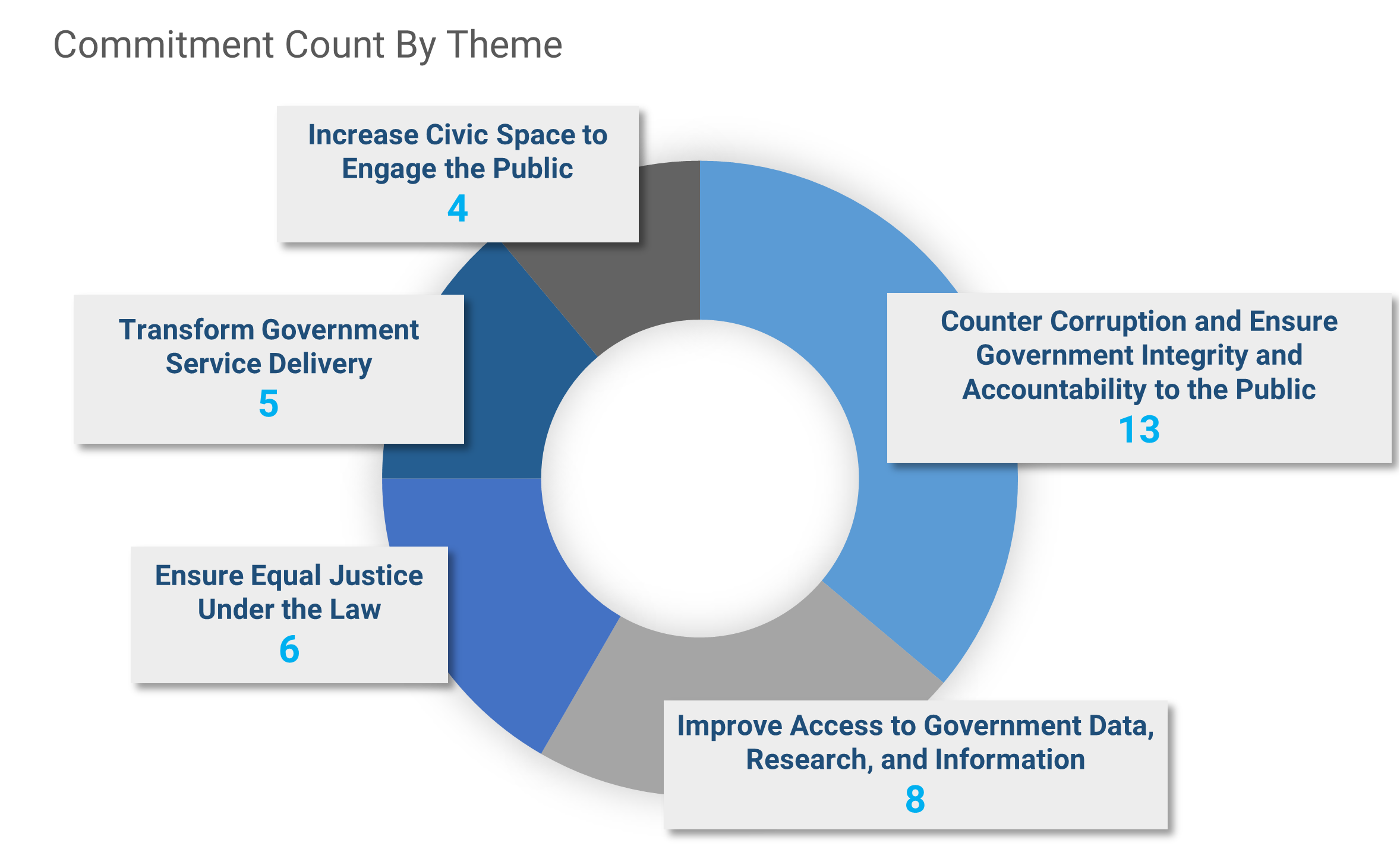
The breakdown of the 36 commitments across the five themes in NAP 5 is depicted in Chart 1 above. While this categorization is the basis for the structure of NAP 5, progress is assessed at the commitment and sub-commitment level, as individual commitments are independent of one another and often have different agency leads for their respective sub-commitments.
Progress To-Date
Chart 2
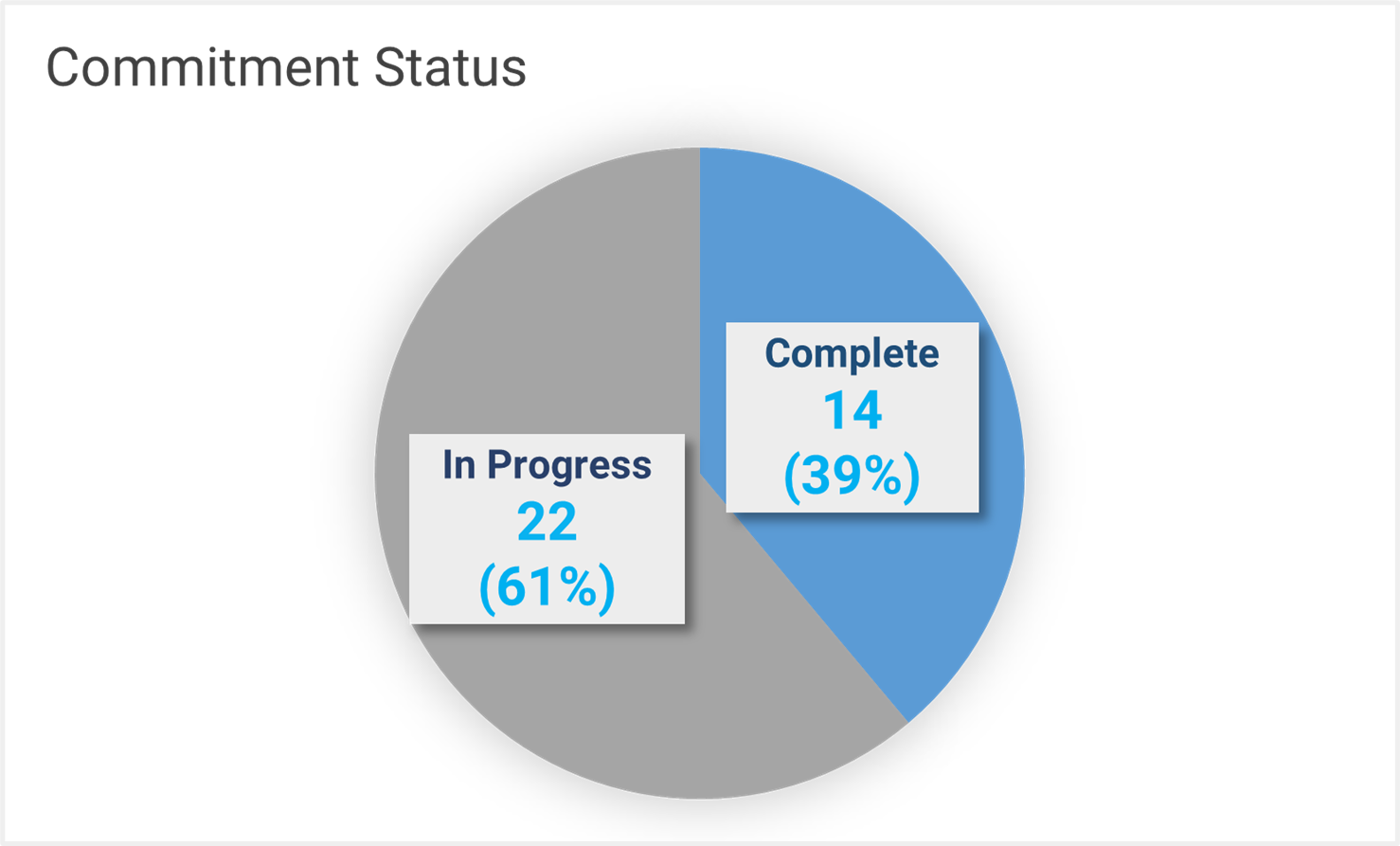
Chart 2 illustrates the current progress of the NAP 5 commitments as of the February 2024 bi-annual commitment update. Both the count and the percentage of the commitments that have been completed and those still in progress are shown. For the 13 commitments composed of two or more sub-commitments, a commitment is considered “Complete” only if all its composite sub-commitments are complete. Information about planned next steps for in progress commitments (broken down at the sub-commitment level) is available on the online tracker.
Chart 3
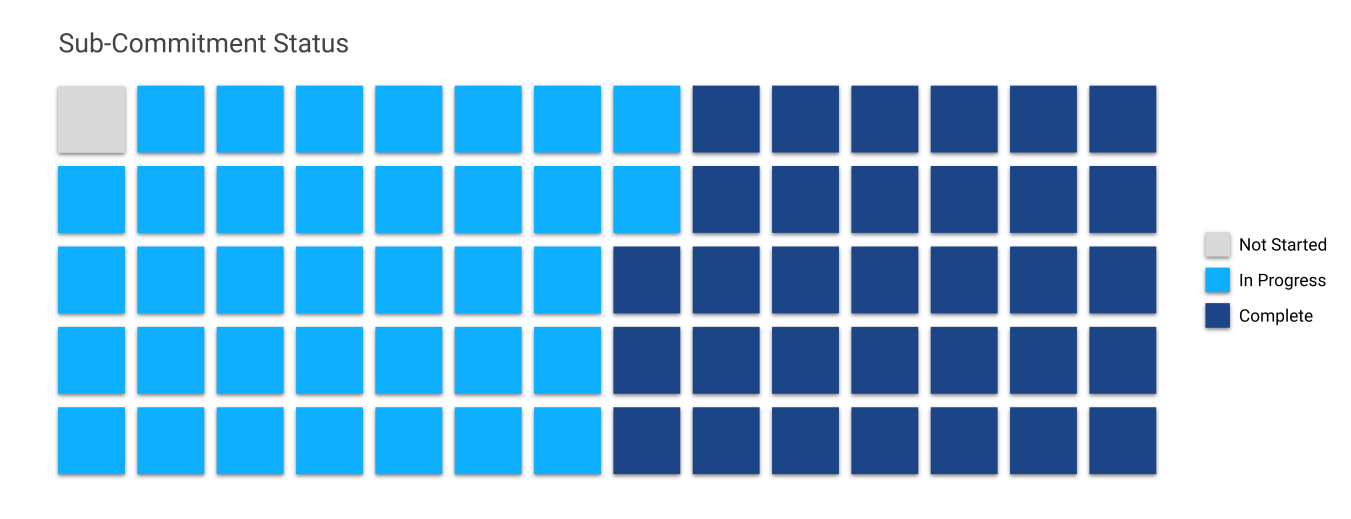
Chart 3 depicts the completion status of the NAP 5 sub-commitments. The chart contains 5 rows of 14 boxes, for a total of 70 boxes representing the 70 sub-commitments. Currently, there are slightly more “In Progress” sub-commitments (36 sub-commitments) than there are “Complete” sub-commitments (33 sub-commitments). Of note, only one sub-commitment–Commitment 118.2–has a status of “Not Started.” The U.S. National Archives and Records Administration (NARA), the commitment owner, needs funding appropriated in order to begin its website redevelopment efforts that will advance this sub-commitment status to “In Progress.”
Chart 4
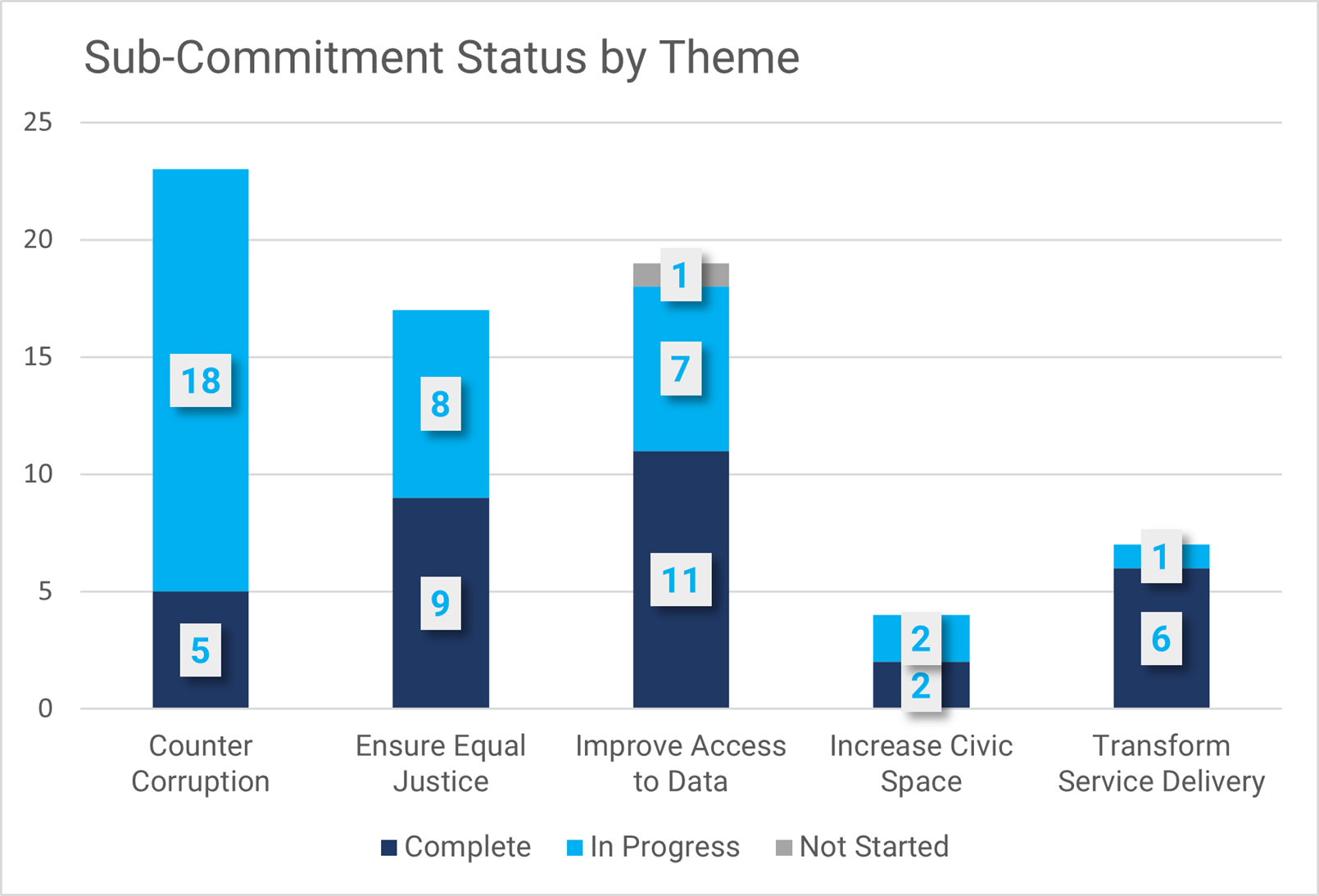
Chart 4 provides an additional summary of the 70 sub-commitments’ completion status, now categorized into NAP 5’s five themes. For each possible status (Complete, In Progress, Not Started), the count is provided for each of the five themes.
Chart 5

The line graph presented in Chart 5 demonstrates the decrease in count of “In Progress” sub-commitments from the initial release of NAP 5 in December 2022 and through the two bi-annual status updates to date (August 2023 and February 2024). This downward-sloping line reflects achievement in fulfilling the goals of sub-commitments set out by the 5th NAP.
Additional Details
Chart 6
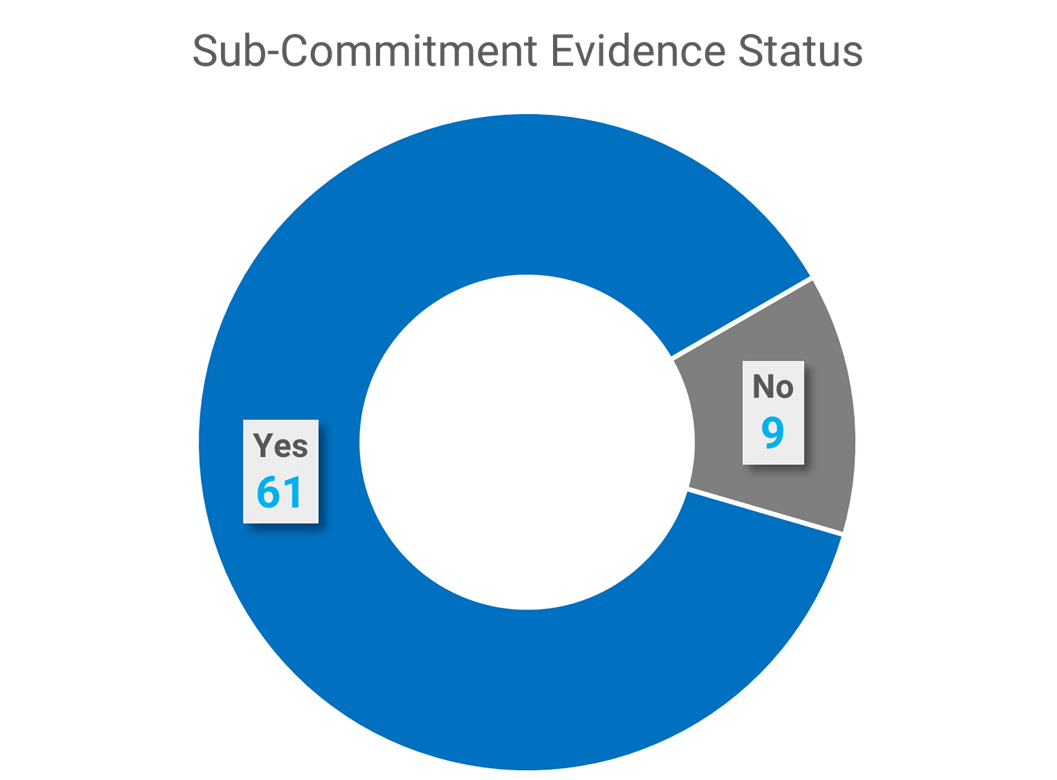
Chart 6 depicts the number of sub-commitments out of the 70 total that have evidence publicly available in the online tracker versus the number that do not. Of the nine sub-commitments shown in Chart 6 to not currently have accompanying public links or other evidence.
Chart 7

Chart 7 shows their current status. Among these nine sub-commitments lacking public evidence, six are still in progress and one hasn’t commenced work, suggesting the potential to obtain evidence upon completion of these commitments. The GSA Open Government Secretariat will work with the sub-commitment agency owners to obtain evidence wherever possible. However, the two completed commitments lack public evidence due to the nature of their respective work, highlighting the complexity and diverse outcomes amongst the commitments.
Chart 8

In its report released in December 2023 assessing the U.S.’s 5th National Action Plan, the Independent Reporting Mechanism evaluated the 36 commitments and assessed their strengths and value to progressing open government principles along three lines: verifiability, open government lens, and potential for results. Chart 8 delineates the progress in the completion status of the four commitments identified by the IRM as meeting all three criteria. Each commitment (Commitments 113, 116, 120, and 130) showcases varying degrees of progress across its sub-commitments, highlighting both areas of achievement and opportunities for further focus.
Lessons and Insights
The development and implementation of NAP 5 have provided the U.S. government with several key lessons and insights. These lessons emphasize the critical role of collaboration, transparency, and adaptability in the successful execution of a co-creation process and open government initiatives within the United States:
- Importance of Inclusive Stakeholder Engagement: Engaging a diverse range of civil society and government stakeholders in a meaningful way at multiple points in the co-creation process is crucial for ensuring that the action plan reflects a wide range of perspectives and priorities. This includes needing to increase public transparency into how public feedback is incorporated into draft and final products. It also requires accounting for the unique challenges this deliberate approach presents in reaching and effectively involving critical voices.
- Clear Accountability Mechanisms: Assigning clear government leads for each commitment enhances accountability and ensures intended outcomes.
- Monitoring and Feedback: Establishing a platform for tracking progress and incorporating feedback helps to make the process transparent and responsive. Cultivating a culture of performance management through regular engagement sessions and actively seeking comprehensive feedback and monitoring from a diverse array of stakeholders supports continuous improvement.
- Building Trust and Ambition: Addressing previous challenges head-on helps in regaining trust and setting more ambitious goals for open government initiatives.
- Focusing Scope: Focusing on eight to 12 SMART commitments which directly support open government objectives will enable the United States to focus its resources and increase the likelihood that ambitious goals are successfully implemented.
Recommendations
Successful implementation during the second and final year of NAP 5 will require collaborative efforts from government agencies, civil society organizations, and other relevant stakeholders. Based on the results and insights from the mid-term assessment, the U.S. government plans to take the following critical actions:
- Enhancing Stakeholder Collaboration: Further strengthen the dialogue and cooperation between government bodies and civil society organizations through the establishment of an MSF in the form of an Open Government Federal Advisory Committee. This involves actively reaching out to and including underrepresented groups, especially individuals impacted by this work but outside the field of open government, to integrate diverse perspectives into the United States’ processes.
- Refining Accountability Structures: Streamline and clarify the roles and responsibilities of leads for each commitment to ensure better tracking and fulfillment of objectives.
- Expanding and Improving Monitoring: Develop more comprehensive and user-friendly monitoring tools, like an enhanced dashboard for tracking and feedback on the implementation of commitments.
- Addressing Unforeseen Challenges: Identify and address any emerging challenges that were not initially anticipated in the action plan.
- Broadening Involvement: Involve a wider range of stakeholders, including experts, academics, private sector representatives, and grassroots organizations, to bring diverse perspectives and expertise to the table. [4]
[1]: Footnote 1 - United States 5th Open Government National Action Plan. https://open.usa.gov/national-action-plan/5/#a-cross-cutting-theme-advancing-equity-and-inclusion-for-underserved-communities ↩
[2]: Footnote 2 - November 30, 2021 Engagement Session. https://open.usa.gov/meeting/november-2021-public-meeting/ ; April 12, 2022 Engagement Session. https://open.usa.gov/meeting/april-2022-public-meeting ; May 19, 2022 Engagement Session. https://open.usa.gov/meeting/may-2022-public-meeting ↩
[3]: Footnote 3 - October 27 and 28, 2022 Engagement Sessions. https://open.usa.gov/meeting/october-2022-public-engagement ; November 29, 2022 Engagement Session. https://open.usa.gov/meeting/november-2022-public-engagement-increasing-the-accessibility-and-utility-of-government-data ↩
[4]: Footnote 4 - Note: The draft of this report was released for public comment through Federal Register Notice 2024-07900 on April 15, 2024. Comments received are publicly available at https://www.regulations.gov/document/GSA-GSA-2024-0002-0016/comment. ↩

